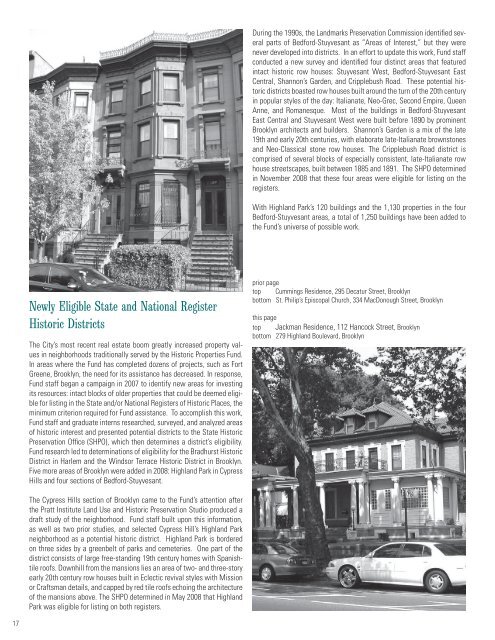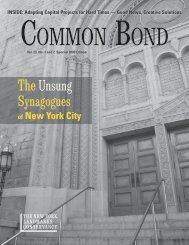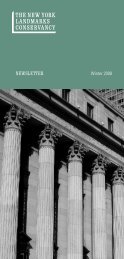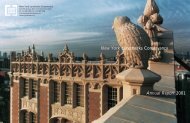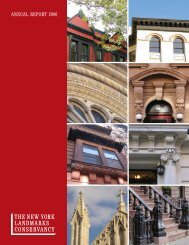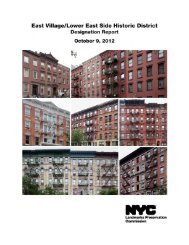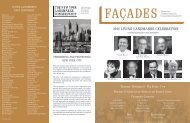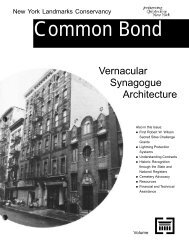ANNUAL REPORT 2008 - The New York Landmarks Conservancy
ANNUAL REPORT 2008 - The New York Landmarks Conservancy
ANNUAL REPORT 2008 - The New York Landmarks Conservancy
Create successful ePaper yourself
Turn your PDF publications into a flip-book with our unique Google optimized e-Paper software.
During the 1990s, the <strong>Landmarks</strong> Preservation Commission identified several<br />
parts of Bedford-Stuyvesant as “Areas of Interest,” but they were<br />
never developed into districts. In an effort to update this work, Fund staff<br />
conducted a new survey and identified four distinct areas that featured<br />
intact historic row houses: Stuyvesant West, Bedford-Stuyvesant East<br />
Central, Shannon’s Garden, and Cripplebush Road. <strong>The</strong>se potential historic<br />
districts boasted row houses built around the turn of the 20th century<br />
in popular styles of the day: Italianate, Neo-Grec, Second Empire, Queen<br />
Anne, and Romanesque. Most of the buildings in Bedford-Stuyvesant<br />
East Central and Stuyvesant West were built before 1890 by prominent<br />
Brooklyn architects and builders. Shannon’s Garden is a mix of the late<br />
19th and early 20th centuries, with elaborate late-Italianate brownstones<br />
and Neo-Classical stone row houses. <strong>The</strong> Cripplebush Road district is<br />
comprised of several blocks of especially consistent, late-Italianate row<br />
house streetscapes, built between 1885 and 1891. <strong>The</strong> SHPO determined<br />
in November <strong>2008</strong> that these four areas were eligible for listing on the<br />
registers.<br />
With Highland Park’s 120 buildings and the 1,130 properties in the four<br />
Bedford-Stuyvesant areas, a total of 1,250 buildings have been added to<br />
the Fund’s universe of possible work.<br />
<strong>New</strong>ly Eligible State and National Register<br />
Historic Districts<br />
<strong>The</strong> City’s most recent real estate boom greatly increased property values<br />
in neighborhoods traditionally served by the Historic Properties Fund.<br />
In areas where the Fund has completed dozens of projects, such as Fort<br />
Greene, Brooklyn, the need for its assistance has decreased. In response,<br />
Fund staff began a campaign in 2007 to identify new areas for investing<br />
its resources: intact blocks of older properties that could be deemed eligible<br />
for listing in the State and/or National Registers of Historic Places, the<br />
minimum criterion required for Fund assistance. To accomplish this work,<br />
Fund staff and graduate interns researched, surveyed, and analyzed areas<br />
of historic interest and presented potential districts to the State Historic<br />
Preservation Office (SHPO), which then determines a district’s eligibility.<br />
Fund research led to determinations of eligibility for the Bradhurst Historic<br />
District in Harlem and the Windsor Terrace Historic District in Brooklyn.<br />
Five more areas of Brooklyn were added in <strong>2008</strong>: Highland Park in Cypress<br />
Hills and four sections of Bedford-Stuyvesant.<br />
prior page<br />
top Cummings Residence, 295 Decatur Street, Brooklyn<br />
bottom St. Philip’s Episcopal Church, 334 MacDonough Street, Brooklyn<br />
this page<br />
top Jackman Residence, 112 Hancock Street, Brooklyn<br />
bottom 279 Highland Boulevard, Brooklyn<br />
<strong>The</strong> Cypress Hills section of Brooklyn came to the Fund’s attention after<br />
the Pratt Institute Land Use and Historic Preservation Studio produced a<br />
draft study of the neighborhood. Fund staff built upon this information,<br />
as well as two prior studies, and selected Cypress Hill’s Highland Park<br />
neighborhood as a potential historic district. Highland Park is bordered<br />
on three sides by a greenbelt of parks and cemeteries. One part of the<br />
district consists of large free-standing 19th century homes with Spanishtile<br />
roofs. Downhill from the mansions lies an area of two- and three-story<br />
early 20th century row houses built in Eclectic revival styles with Mission<br />
or Craftsman details, and capped by red tile roofs echoing the architecture<br />
of the mansions above. <strong>The</strong> SHPO determined in May <strong>2008</strong> that Highland<br />
Park was eligible for listing on both registers.<br />
17


